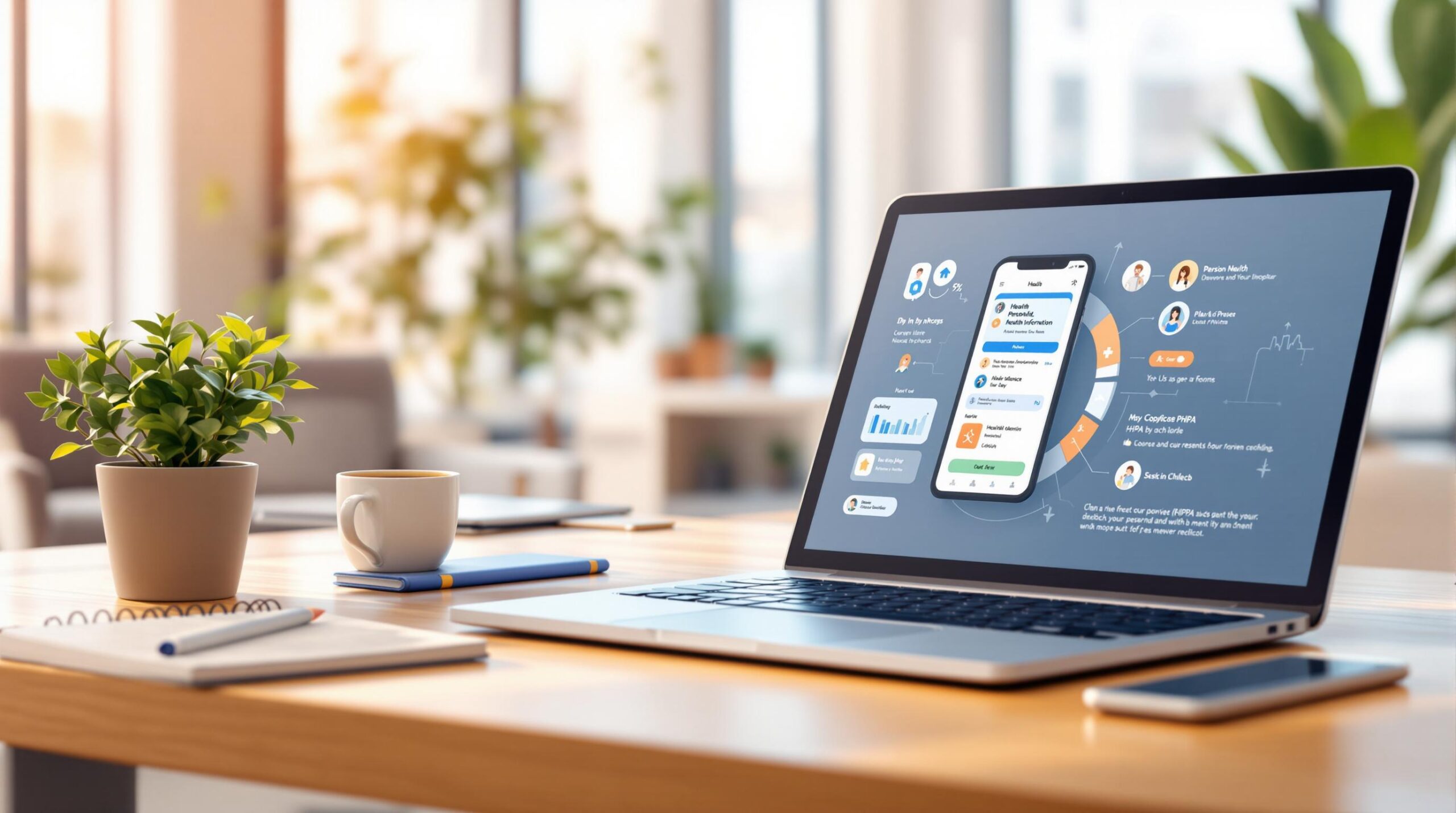
Protecting sensitive health and personal information in mobile apps is crucial in Canada. Failing to comply with PHIPA (Personal Health Information Protection Act) and PIPEDA (Personal Information Protection and Electronic Documents Act) can result in fines of up to $250,000 CAD for PHIPA and $100,000 CAD for PIPEDA violations. Here’s what you need to know:
Key Compliance Steps:
- Data Protection: Encrypt data during storage (AES-256) and transmission (SSL/TLS).
- User Consent: Ensure clear, informed, and ongoing consent with simple privacy settings.
- Access Control: Use multi-factor authentication and role-based access permissions.
- Data Minimization: Only collect and store the data that’s absolutely necessary.
- Regular Testing: Conduct security audits, vulnerability assessments, and penetration tests.
Why It Matters:
The healthcare mobile app market is growing rapidly and is projected to reach $340.5 billion by 2030. Apps must address security and privacy concerns to meet legal standards and build user trust.
| Compliance Area | Key Practices |
|---|---|
| Data Security | Encryption, secure storage, and transit security |
| User Consent | Transparent policies and revocable permissions |
| Access Management | Multi-factor authentication and audit logs |
| Ongoing Monitoring | Regular tests and compliance reviews |
How to Make a HIPAA Compliant App in 2025
Core Compliance Requirements
Meeting PHIPA and PIPEDA standards involves implementing the right technical systems and operational practices. These regulations focus on safeguarding sensitive health information and respecting user privacy.
User Consent Standards
Obtaining meaningful consent is a cornerstone of compliance. According to the Office of the Privacy Commissioner of Canada, consent must be clear, informed, and ongoing.
Apps need to include features like:
- Clear and simple statements explaining data use
- Options for users to decide what data they share
- Easy ways to revoke permissions
- Privacy details presented in user-friendly formats
"Individuals should not be expected to decipher complex legal language in order to make informed decisions on whether or not to provide consent." – Office of the Privacy Commissioner of Canada
Once consent mechanisms are in place, the next step is ensuring strong data protection to keep information secure during storage and transmission.
Data Protection Methods
Data security involves protecting information both when it’s stored and while it’s being transmitted. Here are three critical layers of protection:
| Protection Layer | Required Implementation | Purpose |
|---|---|---|
| Access Security | Multi-factor authentication and automatic logouts | Block unauthorized access |
| Data-at-Rest | Encryption and secure storage in an app sandbox | Safeguard stored data |
| Transit Security | End-to-end encryption and certificate validation | Secure data during transmission |
In addition to these, organizations should implement administrative, physical, and technical safeguards. This includes appointing security officers, conducting risk assessments, and enforcing strict access controls.
Data Collection Limits
Apps must follow the principle of data minimization, which means collecting only the information necessary for their purpose. Key practices include:
- Purpose Limitation: Gather only the data required for the app to function
- Retention Controls: Store data only for as long as needed
- Usage Boundaries: Use data strictly for its intended purpose
- Security Measures: Protect against unauthorized access
Organizations must document and justify their data collection methods. If new uses for the data arise, they must secure fresh consent before moving forward. These practices ensure that only essential information is collected and handled responsibly.
Security Features for Mobile Apps
Building on basic compliance measures, advanced security features add an extra layer of protection by incorporating strong encryption and access protocols.
Data Encryption Systems
Advanced encryption techniques go beyond basic protection. Here’s a breakdown of key encryption layers:
| Encryption Layer | Method | Security Advantage |
|---|---|---|
| Data Storage | AES with Secure Enclave or Android Keystore | Keeps local data safe |
| Data Transit | End-to-End Encryption with Elliptic Curve Cryptography (ECC) | Ensures secure transmission |
| Key Management | Public/private key infrastructure | Enables secure key exchange |
Elliptic Curve Cryptography (ECC) is preferred over RSA for its stronger security and lower computational demands. Tools like the Android Keystore ensure key materials remain isolated from the app process, minimizing exposure risks.
Strong encryption works hand-in-hand with access controls to ensure only authorized users can view protected data.
Access Control Systems
Access control adds another layer of security by managing who can access sensitive data. Here’s how:
-
Authentication Framework
Combine biometric authentication with passwords and include session timeouts to verify users and prevent risks from unattended devices. -
Role-Based Controls
Align access permissions with user roles. For example, a major US healthcare project utilized OAuth2 and JSON Web Token (JWT) to securely manage patient–doctor interactions.
Privacy-First Interface Design
A user-friendly interface with built-in privacy features helps maintain transparency without sacrificing ease of use:
| Design Element | Implementation | Purpose |
|---|---|---|
| Privacy Settings | Easy-to-find in app navigation | Simplifies control access |
| Data Usage & Consent | Real-time notifications with clear consent options | Helps users make informed choices |
| Visual Feedback | Noticeable visual cues | Highlights privacy-related actions |
Privacy policies should be layered, showing key details upfront while offering more in-depth explanations through intuitive navigation. Delivering privacy messages at the right time boosts user awareness and encourages informed decisions.
These features not only meet compliance standards but also support continuous security upgrades.
sbb-itb-7af2948
Long-term Compliance Management
Maintaining PHIPA and PIPEDA standards isn’t a one-time task – it demands ongoing testing, well-trained teams, and detailed record-keeping.
Security Testing Schedule
Regular security tests help identify and address potential threats early. Here’s a breakdown of key tests to include:
| Testing Type | Frequency | Core Elements |
|---|---|---|
| Automated Scans | Daily | Code analysis, dependency checks |
| Vulnerability Assessment | Monthly | System-wide security evaluation |
| Penetration Testing | Quarterly | External security expert review |
| Risk Assessment | Bi-annually | Comprehensive compliance audit |
Incorporating these tests into your continuous integration (CI) pipeline ensures automatic scans with every code update. This approach delivers immediate feedback on potential issues, keeping your systems secure and compliant.
Team Compliance Training
Educating your team is critical for compliance success.
"The Personal Health Information Protection Act (PHIPA) requires that, as a health information custodian (custodian), you must take reasonable steps to ensure that personal health information in your custody or control is protected against theft, loss and unauthorized use and disclosure, and that the records containing the information are protected against unauthorized copying, modification or disposal."
Key training areas include:
- Data Protection Basics: Workshops on encryption, password management, and safe data practices help employees understand their role in safeguarding sensitive information.
- Mobile Device Security: Teach staff how to secure data on mobile devices, including encryption and protocols for handling loss or theft.
- Incident Response: Ensure everyone knows how to identify, report, and respond to security breaches or compliance issues.
Compliance Record Keeping
Keeping thorough records is the final piece of the compliance puzzle. Proper documentation demonstrates your commitment to ongoing standards.
| Documentation Type | Purpose | Update Frequency |
|---|---|---|
| Privacy Policies | Outline data handling procedures | Quarterly review |
| Consent Records | Track user permissions | Real-time updates |
| Incident Reports | Log security events | As needed |
| Training Records | Document staff education efforts | Monthly updates |
Regularly review data maps to ensure they remain accurate and align with regulatory requirements. Together, testing, training, and documentation create a strong foundation for long-term compliance.
Sidekick Interactive‘s Compliance Solutions
Secure App Development Process
Sidekick Interactive prioritizes security in its mobile app development process. By incorporating automated testing, code reviews, and CI/CD deployment, the company ensures sensitive health information is protected while adhering to PHIPA and PIPEDA standards.
| Security Layer | Implementation | Compliance Benefit |
|---|---|---|
| Cloud Infrastructure | SOC 2 Type II certified providers | Validates secure data storage |
| Authentication | Multi-factor authentication | Strengthens access protection |
| Data Protection | End-to-end encryption | Safeguards sensitive information |
| Access Control | Role-based controls | Defines clear access boundaries |
Healthcare Project Experience
Since 2017, Sidekick Interactive has worked with Canadian research facilities to create secure healthcare apps that prioritize data protection. They integrate seamlessly with major Electronic Health Record systems using HL7 v2 and FHIR standards.
The development team focuses on:
- Implementing tested protocols from past healthcare projects
- Embedding privacy-by-design principles into every stage
- Using compliance monitoring tools to ensure ongoing adherence
This expertise shapes their technical strategies for each project.
Technical Partnership Approach
Sidekick Interactive employs a collaborative approach tailored to the specific compliance needs of each project. Their experience and customized solutions help address even complex security challenges effectively.
| Partnership Element | Description | Impact |
|---|---|---|
| Initial Assessment | Reviews compliance requirements | Aligns with PHIPA/PIPEDA |
| Custom Solutions | Develops tailored strategies | Resolves security concerns |
| Ongoing Support | Provides regular updates | Sustains compliance standards |
The team works closely with both technical and non-technical stakeholders to turn applications into secure, compliant systems. This process ensures clear data handling practices and explicit user consent mechanisms, maintaining transparency while meeting PHIPA and PIPEDA requirements.
Next Steps for Compliance
Getting your app ready for PHIPA and PIPEDA compliance requires careful planning and execution. Start by encrypting sensitive data with 256-bit AES for storage and RSA encryption during transit. Protect your networks using HTTPS/SSL/TLS protocols.
| Security Component | Method | Compliance Impact |
|---|---|---|
| Data Protection | 256-bit AES encryption | Keeps sensitive health information secure in storage |
| Network Security | HTTPS/SSL/TLS protocols | Protects data during transmission |
| Access Control | Multi-factor authentication | Blocks unauthorized access |
| Audit Systems | Detailed activity logging | Supports effective compliance monitoring |
These foundational steps create a secure environment for developing compliant healthcare applications. On average, healthcare compliance efforts cost between $60,000 and $190,000, making it essential to work with experts in secure healthcare technology.
Strengthen Data Access Controls
To ensure proper access management, implement the following:
- Multi-factor authentication for additional login security
- Role-based access controls to limit data access by job function
- Regular security audits and penetration testing for vulnerability checks
- Comprehensive audit logs to track all data access activities
Address challenges with mobile devices by using Mobile Device Management (MDM) solutions. MDM allows for remote data wiping and device-level security, ensuring sensitive information remains protected. Additionally, establish clear data backup and disaster recovery protocols to maintain operations while staying compliant.
Build on Industry Standards
Incorporate development teams familiar with HL7/FHIR standards into your security framework. This ensures your technical foundation aligns with healthcare compliance requirements. Pair this with regular compliance monitoring and staff training to maintain adherence to PHIPA and PIPEDA over the long term.


